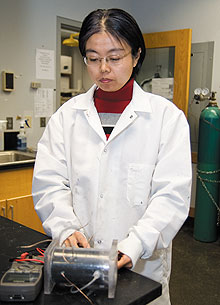  |
| HOME | THIS ISSUE | CALENDAR | GRANTS | BACK ISSUES | < BACK | NEXT > |
Collaboration advances microbial fuel cell commercializationby Nan Cooper - May 4, 2009
|
||||
| Professor Baikun Li and her industrial partners are seeking to harness the energy-production capabilities of microscopic bacteria to produce power and clean wastewater on a large commercial scale. Li, an assistant professor of civil and environmental engineering who is also affiliated with the Center for Environmental Sciences & Engineering (CESE), is working with Connecticut-based engineering consulting firm Fuss & O’Neill to develop large-scale, efficient microbial fuel cells. They have recently received funding for the project from the U.S. Environmental Protection Agency (EPA) and New York State Energy Research & Development Authority. Fuss & O’Neill are subcontractors to HydroQual, a New Jersey-based environmental engineering company that serves as the prime contractor. The grant garnered matching funds from the Water Environment Research Foundation, an international water pollution research and outreach group. The Connecticut Clean Energy Fund has also shown keen interest in the team’s work. Although they have been studied since the early 1900s, microbial fuel cells are still in their infancy, says Li, noting that most research to date has focused on very small-scale lab units. In a microbial fuel cell, a feedstock – in this case, carbohydrate-laden wastewater – is fed into a vacuum-sealed cell, where anaerobic bacteria embedded in a carbon tube dine on the fatty acids, glucose, and other organic carbons prevalent in wastewater. The bacteria degrade these organic compounds and generate protons and electrons. The electrons are transported to an electrode – the anode – and conducted through a copper wire circuit to a second electrode, called a cathode. At the cathode, electrons and protons react with oxygen, generating electricity. A microbial fuel cell operates at room temperature and requires only wastewater as its influent, in contrast with solid oxide fuel cells and most polymer electrolyte membrane fuel cells, which require higher temperatures and pressures, a costly catalyst (often platinum) in the case of polymer electrolyte membrane fuel cells, and additional hydrogen or nitrogen to operate. But while solid oxide fuel cells and most polymer electrolyte membrane fuel cells are costly to operate in comparison with microbial fuel cells, they are considerably more efficient sources of energy, producing about 3,000 watts per cubic meter of energy, in contrast with the approximately 3 watts per cubic meter a microbial fuel cell may produce. Li has been collaborating with Fuss & O’Neill since 2007, when UConn engineering alumnus Michael Curtis, senior vice president of the company’s facilities and environmental systems division, foresaw the potential commercial applications of Li’s work. Fuss & O’Neill has focused increasingly on environmentally sustainable construction and building solutions in recent years, and is involved in the design and construction of dozens of industrial and municipal sewage treatment operations, primarily in the Northeast.
Conventional sewage treatment plants rely on a mixture of processes, including microbes, to produce clean water. In the process, they use huge amounts of power and release tens of millions of tons of carbon dioxide into the atmosphere every year. Curtis says microbial fuel cell technology takes a high-energy resource, such as the carbohydrates in sanitary sewage, and exploits it in energy production. “From a layman’s point of view, it’s like photosynthesis in reverse,” he says. “A microbial fuel cell takes advantage of the seemingly unlimited supply of wastewater carbohydrates and converts it back into usable energy. The carbon supplying the fuel cell has effectively been sequestered from the atmosphere, making this a green, carbon-neutral process.” He adds that if the technological challenges to efficiently scaling up the devices can be addressed, microbial fuel cell technology could “turn a trillion dollar industry on its ear.” The microbial fuel cell under development in Li’s lab uses wastewater as its feedstock. At a small scale, microbial fuel cells can produce a relatively large amount of energy. Their energy conversion capacity declines, however, as the scale is increased, rendering them inefficient power sources currently for most commercial applications. Li and her colleagues seek to develop high-energy output microbial fuel cells and units suitable for various commercial applications. In her UConn laboratory, Li has developed 250 ml and 1 liter microbial fuel cell units. With Fuss & O’Neill, she plans to build and test a 20 liter unit, and this summer, to install pilot scale units at a wastewater treatment facility in upstate New York. UConn’s Center for Science and Technology Commercialization has filed a patent application on these new designs. “Municipal wastewater treatment plants represent a huge energy ‘sink’ in the U.S., consuming an estimated 2 percent to 3 percent of the total power consumed each year across the nation,” says Li. “Ironically, the wastewater is concentrated with carbohydrates that are inherently high energy compounds. If we could harness this untapped resource to produce high quality energy and clean water, we could reverse the current energy balance of sewage treatment facilities.” |
| ADVANCE HOME UCONN HOME |

